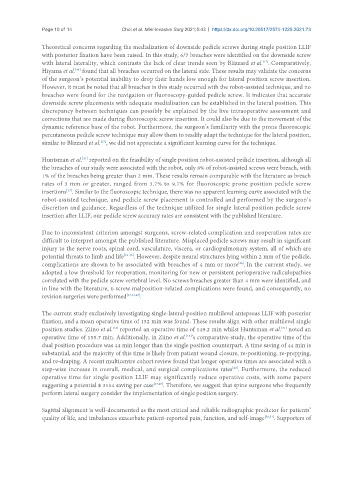Page 446 - Read Online
P. 446
Page 10 of 14 Choi et al. Mini-invasive Surg 2021;5:43 https://dx.doi.org/10.20517/2574-1225.2021.73
Theoretical concerns regarding the medialization of downside pedicle screws during single position LLIF
with posterior fixation have been raised. In this study, 6/7 breaches were identified on the downside screw
[17]
with lateral laterality, which contrasts the lack of clear trends seen by Blizzard et al. . Comparatively,
[43]
Hiyama et al. found that all breaches occurred on the lateral side. These results may validate the concerns
of the surgeon’s potential inability to drop their hands low enough for lateral position screw insertion.
However, it must be noted that all breaches in this study occurred with the robot-assisted technique, and no
breaches were found for the navigation or fluoroscopy-guided pedicle screw. It indicates that accurate
downside screw placements with adequate medialisation can be established in the lateral position. This
discrepancy between techniques can possibly be explained by the live intraoperative assessment and
corrections that are made during fluoroscopic screw insertion. It could also be due to the movement of the
dynamic reference base of the robot. Furthermore, the surgeon’s familiarity with the prone fluoroscopic
percutaneous pedicle screw technique may allow them to readily adapt the technique for the lateral position,
[17]
similar to Blizzard et al. , we did not appreciate a significant learning curve for the technique.
Huntsman et al. reported on the feasibility of single position robot-assisted pedicle insertion, although all
[31]
the breaches of our study were associated with the robot, only 8% of robot-assisted screws were breach, with
1% of the breaches being greater than 2 mm. These results remain comparable with the literature as breach
rates of 3 mm or greater, ranged from 3.7% to 9.7% for fluoroscopic prone position pedicle screw
[17]
insertions . Similar to the fluoroscopic technique, there was no apparent learning curve associated with the
robot-assisted technique, and pedicle screw placement is controlled and performed by the surgeon’s
discretion and guidance. Regardless of the technique utilized for single lateral position pedicle screw
insertion after LLIF, our pedicle screw accuracy rates are consistent with the published literature.
Due to inconsistent criterion amongst surgeons, screw-related complication and reoperation rates are
difficult to interpret amongst the published literature. Misplaced pedicle screws may result in significant
injury to the nerve roots, spinal cord, vasculature, viscera, or cardiopulmonary system, all of which are
potential threats to limb and life [42-45] . However, despite neural structures lying within 2 mm of the pedicle,
[46]
complications are shown to be associated with breaches of 4 mm or more . In the current study, we
adopted a low threshold for reoperation, monitoring for new or persistent perioperative radiculopathies
correlated with the pedicle screw vertebral level. No screws breaches greater than 4 mm were identified, and
in line with the literature, 0 screw malposition-related complications were found, and consequently, no
revision surgeries were performed [17,31,47] .
The current study exclusively investigating single-lateral-position multilevel antepsoas LLIF with posterior
fixation, and a mean operative time of 152 min was found. These results align with other multilevel single
[31]
[18]
position studies. Ziino et al. reported an operative time of 149.2 min whilst Huntsman et al. noted an
operative time of 155.7 min. Additionally, in Ziino et al. ’s comparative study, the operative time of the
[18]
dual position procedure was 44 min longer than the single position counterpart. A time saving of 44 min is
substantial, and the majority of this time is likely from patient wound closure, re-positioning, re-prepping,
and re-draping. A recent multicentre cohort review found that longer operative times are associated with a
[48]
step-wise increase in overall, medical, and surgical complications rates . Furthermore, the reduced
operative time for single position LLIF may significantly reduce operative costs, with some papers
suggesting a potential $ 3154 saving per case [17,49] . Therefore, we suggest that spine surgeons who frequently
perform lateral surgery consider the implementation of single position surgery.
Sagittal alignment is well-documented as the most critical and reliable radiographic predictor for patients’
quality of life, and imbalances exacerbate patient-reported pain, function, and self-image [50,51] . Supporters of

